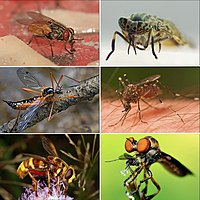
Photo from wikipedia
Aedes aegypti is the most important and widespread vector of arboviruses, including dengue and zika. Insect dispersal through the flight activity is a key parameter that determines vector competence, and… Click to show full abstract
Aedes aegypti is the most important and widespread vector of arboviruses, including dengue and zika. Insect dispersal through the flight activity is a key parameter that determines vector competence, and is energetically driven by oxidative phosphorylation in flight muscle mitochondria. Analysis of mitochondrial function is central for a better understanding of cellular metabolism, and is mostly studied using isolated organelles. However, this approach has several challenges and methods for assessment of mitochondrial function in chemically-permeabilized tissues were designed. Here, we described a reliable protocol to assess mitochondrial physiology using mechanically permeabilized flight muscle of single A. aegypti mosquitoes in combination with high-resolution respirometry. By avoiding the use of detergents, high respiratory rates were obtained indicating that substrate access to mitochondria was not limited. This was confirmed by using selective inhibitors for specific mitochondrial substrates. Additionally, mitochondria revealed highly coupled, as ATP synthase or adenine nucleotide translocator inhibition strongly impacted respiration. Finally, we determined that pyruvate and proline induced the highest respiratory rates compared to other substrates tested. This method allows the assessment of mitochondrial physiology in mosquito flight muscle at individual level, and can be used for the identification of novel targets aiming rational insect vector control.
Journal Title: Analytical biochemistry
Year Published: 2019
Link to full text (if available)
Share on Social Media: Sign Up to like & get
recommendations!